Netherlands
Seitenübersicht
[Ausblenden]1 Overall Information
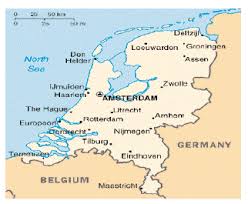
The Netherlands (Fig. 1)
The Netherlands are a western European country located west of Germany and in the north of Belgium, bordering the North Sea. The country exists as such since the year 1581 and has the state form of a unitary parliamentary constitutional monarchy. Currently the Netherlands are governed by Prime Minister Mark Rutte and his party VVD (People´s Party for Freedom and Democracy). Rutte is leading his third cabinet and has been in office since 2010.
The Netherlands have a population of roughly 17.4 million people living on an area of 33.500 square kilometres which makes for a population density of 488 inhabitants per square kilometre. This puts the Netherlands in first place regarding population density inside the European Union and the 12th worldwide.[1] 92.5% of the population are classified as living in urban environment. The countries average age is 43.3 years.
The country is founding member of the European Union and member of nearly every one of the bigger international organisations. Important economic sectors are trade and logistics, the banking sector and the agricultural sector. Despite the countries small size, it is the second largest exporter of agricultural products after the United States.[2] The GDP per capita totals to 58.255 leading to the 13th rank globally. The World Bank classifies the Netherlands as a high-income country.[3] The Netherlands also score really high on the Human Development Index where the country is ranked at tenth place.[4]
The Netherlands have a population of roughly 17.4 million people living on an area of 33.500 square kilometres which makes for a population density of 488 inhabitants per square kilometre. This puts the Netherlands in first place regarding population density inside the European Union and the 12th worldwide.[1] 92.5% of the population are classified as living in urban environment. The countries average age is 43.3 years.
The country is founding member of the European Union and member of nearly every one of the bigger international organisations. Important economic sectors are trade and logistics, the banking sector and the agricultural sector. Despite the countries small size, it is the second largest exporter of agricultural products after the United States.[2] The GDP per capita totals to 58.255 leading to the 13th rank globally. The World Bank classifies the Netherlands as a high-income country.[3] The Netherlands also score really high on the Human Development Index where the country is ranked at tenth place.[4]
2 Preparedness
The first steps of dealing with a crisis are done in times when there is not even yet a crisis. Preparedness refers to the measures that have been implimented in anticipation of a potential crisis and the resources that are available in such a circumstance. The level of preparedness has thereby a huge impact on the ability of a state to deal with a crisis.[5] The Covid-19 Pandemic is no exception as especially in the beginning the reaction time and resources in form of hospital beds and medical equipment of a state became important factors. The upcoming section will provide information on the level of preparedness in the case of the Netherlands.
2.1 Health Sector in General
The Netherlands spend around 10.1 per cent of their GDP for the public health sector and are thereby a bit above the average spending of the European Union member states which is at 9.9 per cent.[6] The health care system revolves around a combination of private insurance which is monitored by the state to guarantee equality and fair conditions. Having health insurance is mandatory in the Netherlands.[7] The Dutch health care system is evaluated very positive by patients. The Swedish think tank Health Consumer Powerhouse published a study in 2015 which ranked health care of European nations according to their popularity among patients. The result named European Health Consumer Index is lead by the Dutch system at rank one followed by Switzerland and Norway.[8] To avoid hospitals being to crowded the Netherlands have a system in which before going to the hospital the individual has to first consult a family doctor. This system is also regarded as being beneficial by foreign medical workers.[9]
2.2 Preparedness for Covid19
How well a country is prepared at the beginning of a crisis can make a big difference throughout it. In January Jaap van Dissel, virologist and director of the Netherlands National Institute for Public Health and the Environment (RIVM) and therefor one of the leading actors during the Covid19-crisis gave an interview about his perception of threat and possible consequences of the epidemic regarding the Netherlands. He highlighted that the Netherlands are well prepared:” Thanks to earlier outbreaks, such as Mexican flu, we have protocols to prevent disease spreading” and furthermore said that: “if the virus does pop up here, it will probably be confined to a handful of cases”.[10] While this prediction was not full on accurate the Netherlands were indeed classified to be one of the best prepared countries by the researchers of the GHSI. The Global Health Security Index (GHSI) measures the capacities of states to deal with a pandemic emergency and ranked the Netherlands third best prepared in the world.[11] However, when it comes to the number of hospital beds available the Netherlands were not equipped all to well. This is highly problematic as the capacity of intensive care beds is deemed to be one of the most important resources in fighting the Covid19-Virus. 3.5 beds per 1000 inhabitants are available in the Netherlands which is below European average. The number is slightly higher than in the countries of Spain and Israel and slightly smaller than in Portugal or Norway.
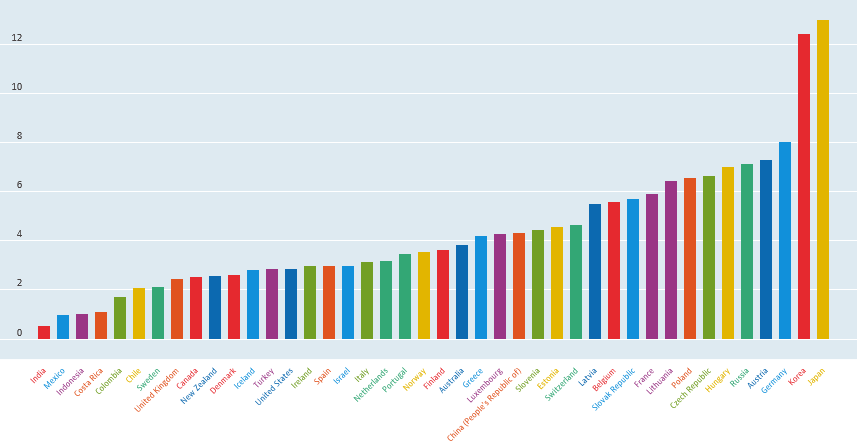
Hospital Beds per 1000 Inhabitants (Fig. 2)
In terms of intensive care beds, the Netherlands performs even weaker. Only 6.4 beds and thereby only roughly half of the European average are available.[12] Thereby the Netherlands are on the bottom end of the European community. Only Finland, Greece, Sweden and Portugal rank lower in the number of critical care beds available.
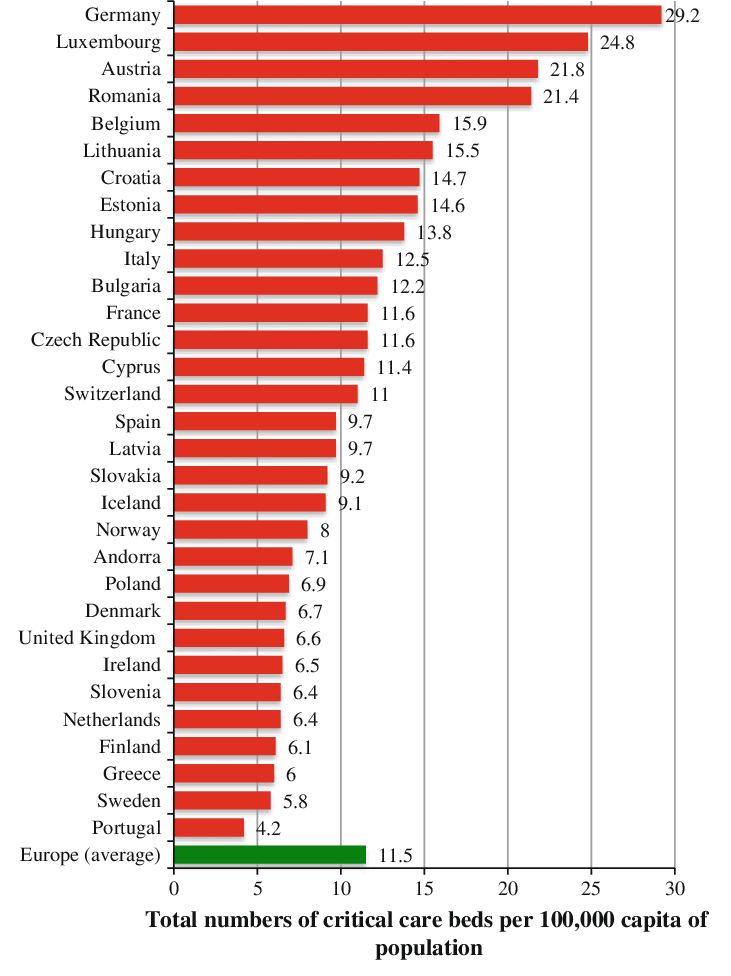
Number of Critical Care Beds per 100.000 Inhabitants (Fig. 3)
3 Sense Making
Sense making during crisis refers to the process of tracking and connecting information in order to be able to find a suiting response. These information have to be interpreted and thereby actors shape the image and develop an understanding of what is going on.[13] During the evolution of the Covid19-crisis it became apparent that knowledge about the infection-rate and its development was essential in order to be able to find fitting measures. Therefor testing people became an essential part in most countries in fighting back against the virus or as the World Health Organisation has put it the best strategy is “testing, testing, testing”.[14] The upcoming abstract will show how the virus has spread across the Netherlands and how the government has tried to monitor these developments.
3.1 Beginning and Spreading
The first case of Covid19 in the Netherlands occurred on the 27th of February.[15] The person diagnosed was a man returning from the Lombardy in Italy. The government tried to find every person he was in contact with but was not able to. Later the RIVM found out through modelling that the virus must have been in the country around two weeks before the first case was recognised, which made backtracking impossible.[16] The first person that died of the Covid19-Virus did so on March 6. It was an 86-year-old man with pre-existing health conditions[17] . In the upcoming weeks, the virus spread within the country with the region of North-Brabant being the one hit most hard. Overall, the south-west of the Netherlands was much harder affected by the virus than the rest of the country.
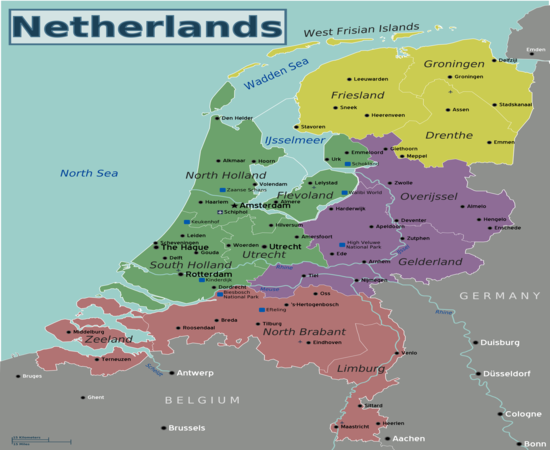 Regions of the Netherlands (Fig. 4) | 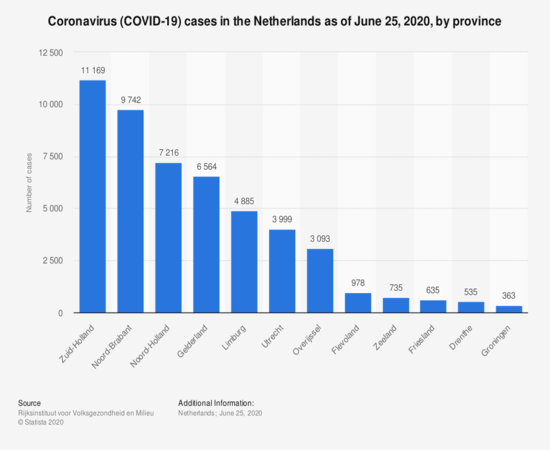 Cases sorted by Province (Fig. 5) |
There are two reasons being most likely responsible for the regional differences of the spread. First the southern part of the Netherlands has a later holiday-term than the rest of the country. People coming back from vacations for example from skiing trips in Austria or Northern-Italy have therefor a higher chance of being infected as the spread of infection in these countries was further progressed. The second reason can be explained by looking at the cultural traditions of the region North-Brabant. Every year in the beginning of spring the region is the scene of enormous carnival celebrations. Normal day life is nearly stopped as roads are blocked, and the end of winter is celebrated, and parades are held. In some parts of the region this goes on for a whole week. With so many people being close together, drinking and hugging the risk of spreading a disease is unlike higher.[18]
3.2 Overall Development
The number of new infections rose steadily from the beginning and peaked around the mid of April. From this point on the numbers decreased overall with some spikes occurring. In the end of July the number of new infections started to rise once again as it did in most European countries. Up until now the country has a number of 53.621 cases of infections and 6.147 people have died as a result of the virus (as of 29th of July 2020).[19]
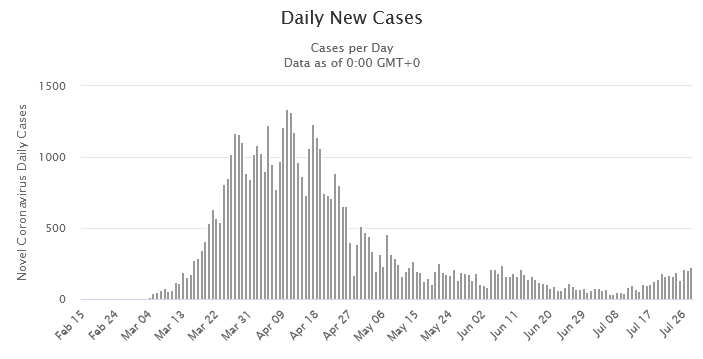 Daily Cases (Fig. 6) | 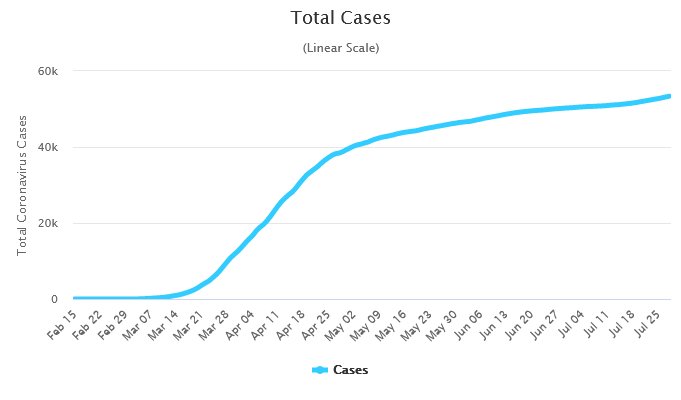 Development of the number of cases (Fig. 7) |
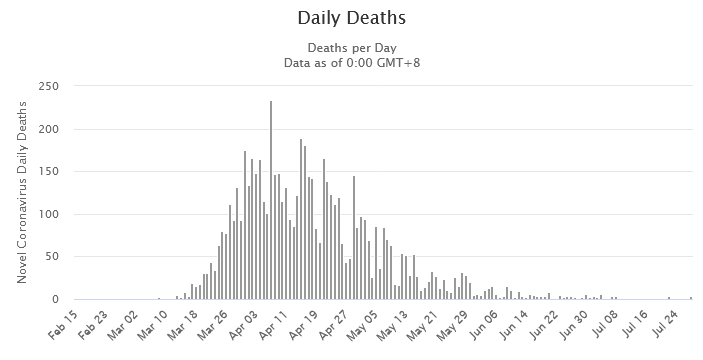 Daily Deaths (Fig. 8) | 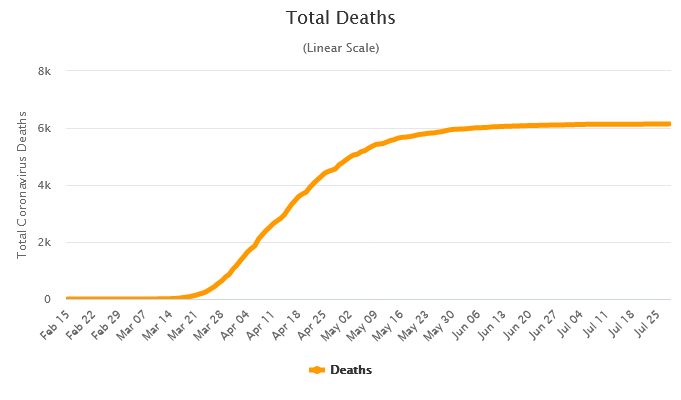 Development of the Number of Deaths (Fig. 9) |
3.3 Testing
At the beginning of the crisis the Netherlands announced that not everyone will be tested for the Covid19-Virus but only the people where there is a reason to do so. This includes individuals with severe symptoms, as well as people who have been in close contact with someone who has been diagnosed with Covid19 and medical care workers and staff that are responsible for older people at higher risk.[20] It was argued that resources should be bundled to help the people who needed them most as there were shortages in laboratory supply.[21]
By the end of April Germany offered the Netherlands 5.000 additional tests per day done by a laboratory in Cologne. The Dutch government however rejected the offer claiming that testing capacities were sufficient.[22] The different perception of what sufficient testing means is most possibly the result of the Dutch taking a different path in fighting the virus with their approach of what has been called an “Intelligent Lockdown”. This is centred around the expectation that most of the population will be infected, nonetheless.
With the start of June 2020, the government announced that everybody who wants to be tested from now on can be tested who showcases any indicators of being sick.[23]
By the end of April Germany offered the Netherlands 5.000 additional tests per day done by a laboratory in Cologne. The Dutch government however rejected the offer claiming that testing capacities were sufficient.[22] The different perception of what sufficient testing means is most possibly the result of the Dutch taking a different path in fighting the virus with their approach of what has been called an “Intelligent Lockdown”. This is centred around the expectation that most of the population will be infected, nonetheless.
With the start of June 2020, the government announced that everybody who wants to be tested from now on can be tested who showcases any indicators of being sick.[23]
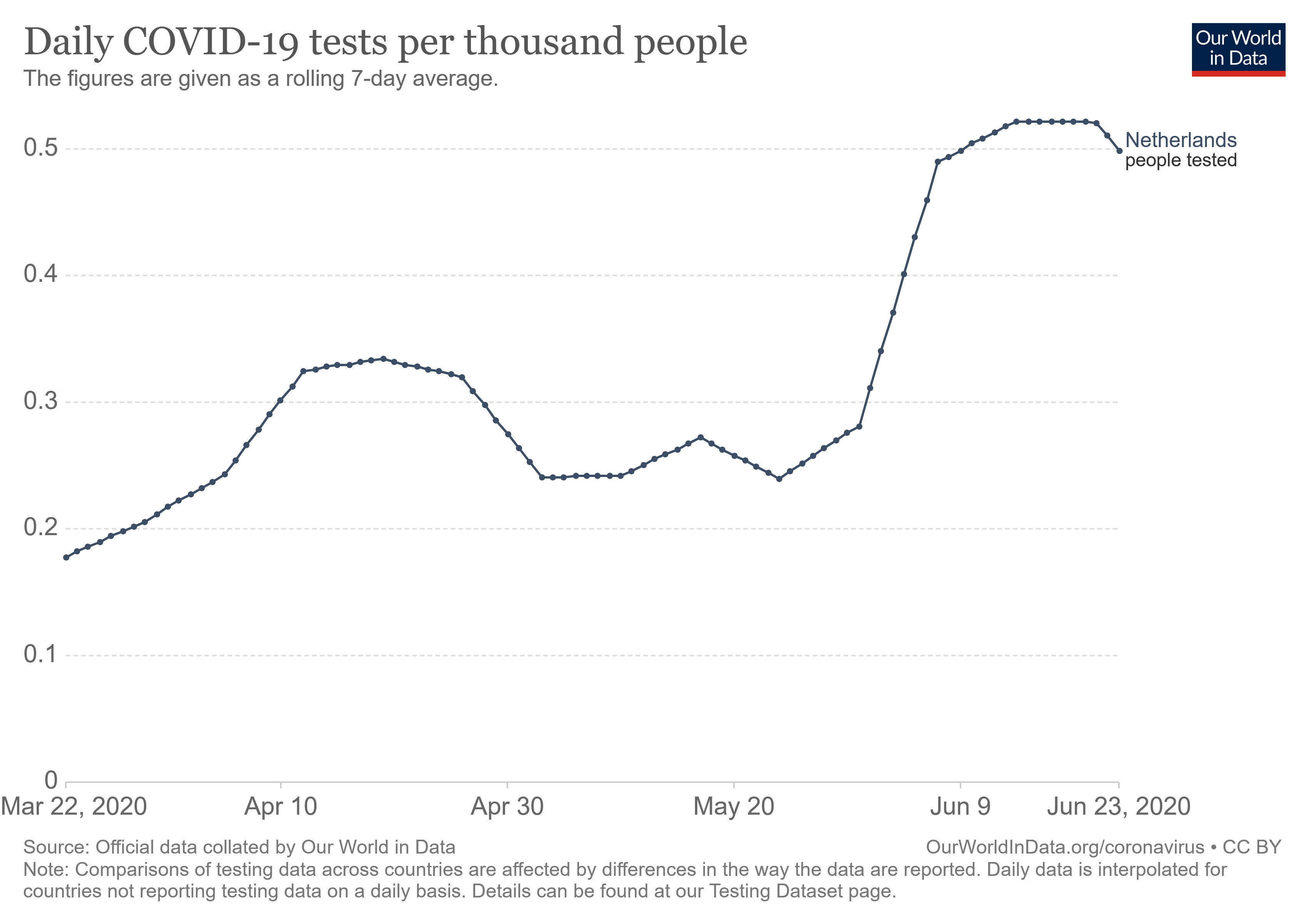
Tests performed per 1000 Inhabitants over Time (Fig. 10)
The new numbers of people who have been infected by the Covid19-virus have been announced on a daily basis by the government of the Netherlands. This reporting of cases contains information about new cases as well as an update on the number of people who have deceased as a result of Covid19. The updates have been accompanied by an assessment of government experts, an estimation of how the numbers will evolve over the next time and an offer of additional information.[24]
3.4 Mink Farms as Hotspots
Mink farms in the Netherlands which produce fur and are part of the agricultural sector have shifted into the centre of attention in May 2020. After several mink farms were reported of being contaminated. The government feared that these farms would become hotspot of reinfection as it was possible that the disease was transmitted from minks to humans if there was close contact.[25] Following advice by disease experts it was decided that all of the minks in farms infected had to be culled.[26]
4 Decision Making
Decision-making refers to the process of choosing which measures to take in the face of crisis and the act of implementing these decisions. A central aspect thereby is the coordination of actors involved and the allocation of scarce resources.[27] The way a country responds to a crisis is obviously of great importance and decisive regarding whether a government is able to contain the crisis. The upcoming abstracts will describe the measures the Dutch government has taken and how these fit to the overall political culture, as it will be shown that norms and values of a society play an important role in determining the decision-making process.
4.1 Overview
The Dutch approach in dealing with the Covid19-Crisis is a rather unique one as the strategy was readjusted several times resulting in it being what can be describe as a mixture of rather different approaches other states did. In the early stages the strategy resembled most closely the highly liberal approaches of Great Brittain and Sweden. The plan of the government was to keep the country open. But as the number of cases increased the Dutch government felt the pressure to readjust its course and do what Prime Minister Rutte called an "Intelligent Lockdown". This differed from the lockdowns most of the European neighbour countries like France and Germany had imposed as people would continue to go to work and most of the stores were kept open. The plan was to develop a tracking-app to help in containing the virus. The app was planned to be a core element in fighting against the virus. This would have resulted in the Netherlands having a similar strategy as some Asian countries like Taiwan and South Korea. However, these plans had to be burried as public concerns about privacy and data security made the implementation of an app impossible.
Overall the Dutch approach can be described as being more liberal as most other European approaches. The government relied heavily on recommendations throughout the crisis and only imposed restrictions as a last resort. They therefore heavily relied on the trust of their citizens while simultaniously putting a lot of trust in them.
Overall the Dutch approach can be described as being more liberal as most other European approaches. The government relied heavily on recommendations throughout the crisis and only imposed restrictions as a last resort. They therefore heavily relied on the trust of their citizens while simultaniously putting a lot of trust in them.
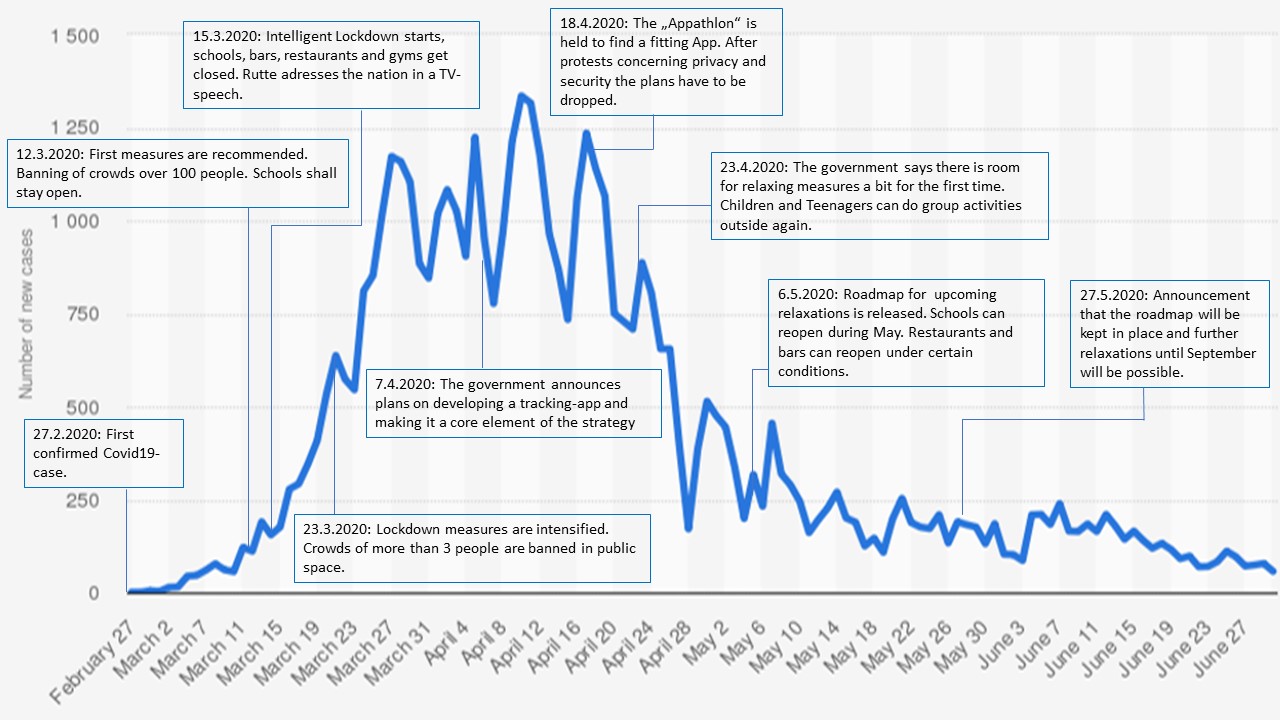
Timeline of the Most Important Measures Taken (Fig. 11)
4.2 Intelligent Lockdown
The initial strategy regarding having a lockdown was fairly liberal. Unlike countries such as France, Germany or Spain no hard lockdown took place. The strategy especially in the beginning of the crisis resembled most closely the one Sweden followed. On March 9 Prime Minister Marc Rutte announced first measures against the pandemic. In difference to most of its European neighbours the Dutch government limited his first responses to sole advices. This involved dissuading hand shaking as well as the recommendation to work from home for people in the region hardest hit at that time Noord-Brabant.[28] At this time more than one third of the 320 people tested positive came from the region.
On March 12 the advice to work from home if possible was extended to the whole country alongside new measures. Gathering of more than one hundred people were banned and elderly people and such with a medical condition were urged to minimize visiting public space and transport. At first the plan was to keep Schools open.[29] The banning of crowds over one hundred people aside all of these measures were still only recommendations. Especially the decision to keep schools open sparked a lot of criticism. Rutte argued that children were not at risk from the pandemic and that closing school would have severe consequences as it would require essential workers to stay at home and thereby worsen the situation. Teachers and school staff voiced concerns over this statement feeling unsafe as there was no proof that children could not bear or spread the virus[30] .
Only three days later on March 15 Prime Minister Mark Rutte had to readjust his governments course after heavy criticism from within the general public and the political opposition and the increasing number of cases. The Netherlands did not fully commit to the liberal approach of simply keeping the country open as Sweden did and shifted to a soft form of lockdown. Schools and day-cares were now shut down until at least April 6 as well as sport clubs, gyms, bars, restaurants and cafes. The measures were immediately in effect and the population was advised to keep a distance of 1.5 meters from one another.[31] One day afterwards the Prime Minister felt the need to address the public in a tv-interview and line out the plan with which he wanted to bring the Netherlands through the crisis. Rutte voiced understanding for the fears of people in the face of uncertainty in this crisis which was taking the entire World hostage. But he also emphasized that precipitate action is not always the best advisor facing crisis and that the best way manoeuvring through these times is to listen to science and experts. In this regards he explained that it will take months maybe even years to find a vaccine. The Netherlands are an open country and can not be kept completely shut down for such a long time period. Therefore, he said that the aim is to contain the virus as good as possible while herd immunity grows within the population. This approach is highly controversial amongst European nations, only Great Britain openly declared herd immunity as the aim for the upcoming weeks. Rutte explained that people usually are immune after catching the virus the first time. Therefor business in general should remain open. People most vulnerable to the virus should be kept safe and by stretching new infections over a longer period an overload of the health capacities should be prevented. To stretch out the rate of infections Rutte appealed to the common sense of people to avoid close personal contact with strangers. The people being immune were planned on forming a “protective wall” around the vulnerable people in the future. He finished his speech with an appeal to help each other and work together in the upcoming months.[32] These measures were described as an “intelligent lockdown” as only high-risk areas were shut down while most business with perceived low risk of infection was held open.
This did not prevent the fact that the government of the Netherlands found itself constrained to aggravate the measures once again on March 23. The measures contained the banning of public gatherings outside of more than three people until the beginning of June and the restriction of not having more than three visitors at the same time in your home. Businesses had to take actions that guaranteed people within are able to keep a safe distance of 1.5 meters. Businesses that required personal contact such as hairdressers and massage studios had to be temporarily closed. The government furthermore strengthened the rights and power of regional authorities. Mayors were now able to independently close areas such as parcs, beaches and playgrounds if they feel these areas are at risk of becoming spots of disease spreading.[33]
After neighbouring countries France and Belgium had already extended the lockdown measures roughly a week earlier the Netherlands also extented the lockdown until the end of April. Schools would be remained closed at least until the of holidays in May. The government emphasized that the rate of new infections while still increasing had slowed down and that measures are working but also that there is still a long way to go.[34]
The first steps back to normality were made on April 21. The government announced that the number of patients was falling steadily and that there was for the first-time space for relaxing the restrictions a little bit. Measures in general were extended until May 19 but under certain conditions primary schools would be allowed to reopen after the holidays in May and secondary schools at the start of June. These conditions included for example class size being halved and the freedom for different schools to adjust by staying closed if they perceived the risk as to high. Children and teenagers are granted more freedoms for participating in group sport events outside.[35]
On May 6, a plan on further relaxing the restrictions was published. Hairdressers, librarians and car instructors could go back to work. From June on restaurants and cafes were allowed to reopen with the restriction that outside people had to be able to remain 1.5 meters of distance and inside there was a maximum of 30 people including staff. The 30 people inside rule was also in place for cultural institutions like theatres and cinemas also from the start of June on. People were advised to wear masks in public transport, from June on they were mandatory as train service went back to normal operation mode. Further easing was held in prospect for the beginning of August and September.[36] .
The government announces on May 27 that the roadmap for relaxation released in the beginning of May will be carried out like proposed with only some minor adjustments. Chances for further measures being ceased in July are good[[37] .
On March 12 the advice to work from home if possible was extended to the whole country alongside new measures. Gathering of more than one hundred people were banned and elderly people and such with a medical condition were urged to minimize visiting public space and transport. At first the plan was to keep Schools open.[29] The banning of crowds over one hundred people aside all of these measures were still only recommendations. Especially the decision to keep schools open sparked a lot of criticism. Rutte argued that children were not at risk from the pandemic and that closing school would have severe consequences as it would require essential workers to stay at home and thereby worsen the situation. Teachers and school staff voiced concerns over this statement feeling unsafe as there was no proof that children could not bear or spread the virus[30] .
Only three days later on March 15 Prime Minister Mark Rutte had to readjust his governments course after heavy criticism from within the general public and the political opposition and the increasing number of cases. The Netherlands did not fully commit to the liberal approach of simply keeping the country open as Sweden did and shifted to a soft form of lockdown. Schools and day-cares were now shut down until at least April 6 as well as sport clubs, gyms, bars, restaurants and cafes. The measures were immediately in effect and the population was advised to keep a distance of 1.5 meters from one another.[31] One day afterwards the Prime Minister felt the need to address the public in a tv-interview and line out the plan with which he wanted to bring the Netherlands through the crisis. Rutte voiced understanding for the fears of people in the face of uncertainty in this crisis which was taking the entire World hostage. But he also emphasized that precipitate action is not always the best advisor facing crisis and that the best way manoeuvring through these times is to listen to science and experts. In this regards he explained that it will take months maybe even years to find a vaccine. The Netherlands are an open country and can not be kept completely shut down for such a long time period. Therefore, he said that the aim is to contain the virus as good as possible while herd immunity grows within the population. This approach is highly controversial amongst European nations, only Great Britain openly declared herd immunity as the aim for the upcoming weeks. Rutte explained that people usually are immune after catching the virus the first time. Therefor business in general should remain open. People most vulnerable to the virus should be kept safe and by stretching new infections over a longer period an overload of the health capacities should be prevented. To stretch out the rate of infections Rutte appealed to the common sense of people to avoid close personal contact with strangers. The people being immune were planned on forming a “protective wall” around the vulnerable people in the future. He finished his speech with an appeal to help each other and work together in the upcoming months.[32] These measures were described as an “intelligent lockdown” as only high-risk areas were shut down while most business with perceived low risk of infection was held open.
This did not prevent the fact that the government of the Netherlands found itself constrained to aggravate the measures once again on March 23. The measures contained the banning of public gatherings outside of more than three people until the beginning of June and the restriction of not having more than three visitors at the same time in your home. Businesses had to take actions that guaranteed people within are able to keep a safe distance of 1.5 meters. Businesses that required personal contact such as hairdressers and massage studios had to be temporarily closed. The government furthermore strengthened the rights and power of regional authorities. Mayors were now able to independently close areas such as parcs, beaches and playgrounds if they feel these areas are at risk of becoming spots of disease spreading.[33]
After neighbouring countries France and Belgium had already extended the lockdown measures roughly a week earlier the Netherlands also extented the lockdown until the end of April. Schools would be remained closed at least until the of holidays in May. The government emphasized that the rate of new infections while still increasing had slowed down and that measures are working but also that there is still a long way to go.[34]
The first steps back to normality were made on April 21. The government announced that the number of patients was falling steadily and that there was for the first-time space for relaxing the restrictions a little bit. Measures in general were extended until May 19 but under certain conditions primary schools would be allowed to reopen after the holidays in May and secondary schools at the start of June. These conditions included for example class size being halved and the freedom for different schools to adjust by staying closed if they perceived the risk as to high. Children and teenagers are granted more freedoms for participating in group sport events outside.[35]
On May 6, a plan on further relaxing the restrictions was published. Hairdressers, librarians and car instructors could go back to work. From June on restaurants and cafes were allowed to reopen with the restriction that outside people had to be able to remain 1.5 meters of distance and inside there was a maximum of 30 people including staff. The 30 people inside rule was also in place for cultural institutions like theatres and cinemas also from the start of June on. People were advised to wear masks in public transport, from June on they were mandatory as train service went back to normal operation mode. Further easing was held in prospect for the beginning of August and September.[36] .
The government announces on May 27 that the roadmap for relaxation released in the beginning of May will be carried out like proposed with only some minor adjustments. Chances for further measures being ceased in July are good[[37] .
4.3 App Development
After keeping the country completely open was off the table The Dutch government initially wanted to go with a similar anti-virus strategy as the Asian countries Taiwan and South Korea. These countries had started using electronic monitoring and digital footprints to be able to track and contain the spreading of the disease. On April 7 Prime Minister Rutte and Minister of Health de Jonge announced that the Netherlands strived to develop two Apps to help fighting back the Covid19-pandemic.[38] One app being designed to track infected people and alarm the ones which might have been in contact with them, the other one designed to stay in contact with medical staff providing monitoring in case of alarming symptoms with the aim of decreasing pressure from hospitals. At this time the government even considered to make the app mandatory.[39]
The Public Health Ministry set out a competition for businesses and developers to construct such an app, the goal was to have it ready by the end of April. High hopes were projected into the App development, with it even being called the core of the new testing policy. On a livestreamed event called “Appathon” the government run tests with seven Apps selected out of 63. Experts criticised the procedure harshly as non-transparent and unsafe. 9 experts involved in the process dropped out and wrote an open letter saying the selection process did not follow any identifiable criteria and that Apps already sorted out nonetheless made it to the final stage while promising ones were left out. The guidelines on developing a tracking app by the European Commission were not considered in any means.[40]
A discussion across the general public evolved around the potential violation of privacy rights. Two days later the attorney-general had to announce that none of the seven apps fulfilled the governments criteria. The government announced it will now develop its own tracking app.
Experts stayed critical arguing that a tracking app is useless unless the test capacities did not increase dramatically it is calculated that in order to be effective an app would have to be accompanied by 100.000 tests a day. If not matched with proper amounts of tests a tracking app would send everyone in contact with an infected person in isolation. This would result with millions locked down within two weeks as experts calculated.[41] Furthermore, in order to be effective at least 60 per cent of the population would have to download the app which was not very likely to happen if not made mandatory.[42] The general public kept voicing concerns about privacy and data security and broadly rejected the idea of a mandatory app. After this push-back a mandatory download of the tracking.app as Rutte had considered previously like in Taiwan or South Korea was off the table.
The push for the tracking app has since than slowed down. The government does not want to risk another failure. An app which fits security and privacy regulations is in development and the government tries to appeal to the general public to use it once finished on a voluntary base.[43] . The general public however does not seem to be completely convinced but rather remains divided on whether a tracking-app is a good idea.
On the 21 of April the OVLG hospital in Amsterdam releasd an App called “De Corona Check”. People who believe to have symptoms can download it and stay in contact with medical staff.[44] The app allows to upload medical data and the doctor is able to contact the patient via video-calling. This is designed to help monitoring Covid19-symptoms and release some pressure for the medical staff on site.[45]
The Public Health Ministry set out a competition for businesses and developers to construct such an app, the goal was to have it ready by the end of April. High hopes were projected into the App development, with it even being called the core of the new testing policy. On a livestreamed event called “Appathon” the government run tests with seven Apps selected out of 63. Experts criticised the procedure harshly as non-transparent and unsafe. 9 experts involved in the process dropped out and wrote an open letter saying the selection process did not follow any identifiable criteria and that Apps already sorted out nonetheless made it to the final stage while promising ones were left out. The guidelines on developing a tracking app by the European Commission were not considered in any means.[40]
A discussion across the general public evolved around the potential violation of privacy rights. Two days later the attorney-general had to announce that none of the seven apps fulfilled the governments criteria. The government announced it will now develop its own tracking app.
Experts stayed critical arguing that a tracking app is useless unless the test capacities did not increase dramatically it is calculated that in order to be effective an app would have to be accompanied by 100.000 tests a day. If not matched with proper amounts of tests a tracking app would send everyone in contact with an infected person in isolation. This would result with millions locked down within two weeks as experts calculated.[41] Furthermore, in order to be effective at least 60 per cent of the population would have to download the app which was not very likely to happen if not made mandatory.[42] The general public kept voicing concerns about privacy and data security and broadly rejected the idea of a mandatory app. After this push-back a mandatory download of the tracking.app as Rutte had considered previously like in Taiwan or South Korea was off the table.
The push for the tracking app has since than slowed down. The government does not want to risk another failure. An app which fits security and privacy regulations is in development and the government tries to appeal to the general public to use it once finished on a voluntary base.[43] . The general public however does not seem to be completely convinced but rather remains divided on whether a tracking-app is a good idea.
On the 21 of April the OVLG hospital in Amsterdam releasd an App called “De Corona Check”. People who believe to have symptoms can download it and stay in contact with medical staff.[44] The app allows to upload medical data and the doctor is able to contact the patient via video-calling. This is designed to help monitoring Covid19-symptoms and release some pressure for the medical staff on site.[45]
4.4 Economic Measures
The Netherlands have taken several measures over the past months to try and soften the economic backlash for the country. As a country heavily reliant on trade, such a global crisis has been a major threat for the Dutch economy. First of all, it should be mentioned that the whole procedure of dealing with the Covid19-crisis also has to be evaluated from an economic perspective. The attempt of the “intelligent lockdown” was trying to find the best compromise between personal safety and economic stability, which of course has also an influence on the personal safety and its perception. Therefore, the whole way of approaching the lockdown can be viewed in regards of trying to minimize the harm for business and individual economic performance. But on top of that the Netherlands have also taken some measures which explicitly strive for economic protection.
On March 15 Secretary for Economic Affairs and Climate Policy announced a package of measures aiming to limit the economic impact of the Covid19-crisis. Businesses and self-employers can apply for bridging loans which are guaranteed by the state. Companies are also allowed to cut working hours with a part of the salary being paid by the government.[46] The possibility to apply is instantly available. This was further specified by the administration on March 17. The government made clear that they are willing to increase the countries debt in face of this crisis and will provide financial aid in the number of billions every month to ensure that the economy will not fall apart. Besides loans companies will be granted tax-cuts. Especially the sectors of gastronomy which is hit especially hard and the sector of agriculture which is the largest motor of the Dutch economy will be protected. The aim is to ensure that companies are able to pay wages to their workers and avoid mass unemployment.[47]
On the 26th of June the Dutch government published that they would provide financial aid to the heavily suffering Dutch airline KLM. The aid consists of a direct loan of one billion euro and a guarantee for additional loans up to 2.4 billion euros. As the reason behind this financial support it is stated that the KLM as the Netherlands biggest airline is of great importance for the country. The payment is furthermore only given under the condition that some adjustments are made. Employees making more than three times of the average for example are given a pay cut and no dividends will be payed to share-holders.[48]
On March 15 Secretary for Economic Affairs and Climate Policy announced a package of measures aiming to limit the economic impact of the Covid19-crisis. Businesses and self-employers can apply for bridging loans which are guaranteed by the state. Companies are also allowed to cut working hours with a part of the salary being paid by the government.[46] The possibility to apply is instantly available. This was further specified by the administration on March 17. The government made clear that they are willing to increase the countries debt in face of this crisis and will provide financial aid in the number of billions every month to ensure that the economy will not fall apart. Besides loans companies will be granted tax-cuts. Especially the sectors of gastronomy which is hit especially hard and the sector of agriculture which is the largest motor of the Dutch economy will be protected. The aim is to ensure that companies are able to pay wages to their workers and avoid mass unemployment.[47]
On the 26th of June the Dutch government published that they would provide financial aid to the heavily suffering Dutch airline KLM. The aid consists of a direct loan of one billion euro and a guarantee for additional loans up to 2.4 billion euros. As the reason behind this financial support it is stated that the KLM as the Netherlands biggest airline is of great importance for the country. The payment is furthermore only given under the condition that some adjustments are made. Employees making more than three times of the average for example are given a pay cut and no dividends will be payed to share-holders.[48]
4.5 Travel restrictions and coordination efforts
The Dutch government has steadily argued that the country is not an isle but instead dependent on its neighbours and trade partners. Therefor the country has made efforts to coordinate with its neighbours and worked towards a common solution. Despite the acknowledgment of the interdependence the country was also forced to adopt some travel restrictions over the duration of the crisis.
On March 13, the government decided to ban incoming flights from high risk regions like Italy and China. Four days later, a travel advice was published recommending travelling abroad only if absolutely essential. The recommendation was the consequence of a decision by the members of the European Union who agreed on restricting travel to the Schengen-area. Due to this travelling back to the Netherlands could be problematic and therefor it was recommended to cancel upcoming travel plans if not full on necessary. These measures were in place from March 19 on.[49] People from outside the European Union who did not fall into one of the exception-categories were not permitted to enter the country[50] .
After Belgium had closed boarders to all travellers an agreement had been reached to allow essential workers crossing the border. Therefor people were able to download a vignette that allowed crossing checkpoints on the border.[51]
With the Easter-weekend on the horizon Prime Minister Mark Rutte urged Belgians and Germans to stay at home and not to spend the weekend in the Netherlands. On the third of June, the Dutch government put out a plan concerning the upcoming holiday season. It is mentioned that the status of European countries is lowered from orange to yellow meaning that the risk of infection in these countries is not above the one in the Netherlands and therefor there is no explicit problem travelling there. Exceptions are Sweden, Denmark and the United Kingdom. The government adviced to consider travelling within the country nonetheless and to avoid travelling to countries outside of Europe. However, it is noteworthy that these are only recommendations.[52] . People are urged to plan their vacations carefully and to be aware of the risks while travelling[53]
With the beginning of July citizens of certain countries outside the EU which were considered to be low-risk were allowed to travel to the Netherlands[54] and on July 16 the Minister of Justice and Security declared that from the end of July onwards travel bans on people from third countries which had a partner in the Netherlands will be eased.[55]
Despite the different measures taken by the different states especially regarding the policies of the borders the Netherlands and their neighbouring countries emphasized that everything is tried to work together and to reach solution beneficial to every country.[56] The strive for united action was also demonstrated by announcing the foundation of a vaccine-alliance on June 3. Germany, Italy, Belgium and the Netherlands want to join forces and negotiate with potential vaccine-manufactures with the aim of having it produced within Europe if possible. The four countries further encourage other members of the European Union to also join the initiative.[57]
On March 13, the government decided to ban incoming flights from high risk regions like Italy and China. Four days later, a travel advice was published recommending travelling abroad only if absolutely essential. The recommendation was the consequence of a decision by the members of the European Union who agreed on restricting travel to the Schengen-area. Due to this travelling back to the Netherlands could be problematic and therefor it was recommended to cancel upcoming travel plans if not full on necessary. These measures were in place from March 19 on.[49] People from outside the European Union who did not fall into one of the exception-categories were not permitted to enter the country[50] .
After Belgium had closed boarders to all travellers an agreement had been reached to allow essential workers crossing the border. Therefor people were able to download a vignette that allowed crossing checkpoints on the border.[51]
With the Easter-weekend on the horizon Prime Minister Mark Rutte urged Belgians and Germans to stay at home and not to spend the weekend in the Netherlands. On the third of June, the Dutch government put out a plan concerning the upcoming holiday season. It is mentioned that the status of European countries is lowered from orange to yellow meaning that the risk of infection in these countries is not above the one in the Netherlands and therefor there is no explicit problem travelling there. Exceptions are Sweden, Denmark and the United Kingdom. The government adviced to consider travelling within the country nonetheless and to avoid travelling to countries outside of Europe. However, it is noteworthy that these are only recommendations.[52] . People are urged to plan their vacations carefully and to be aware of the risks while travelling[53]
With the beginning of July citizens of certain countries outside the EU which were considered to be low-risk were allowed to travel to the Netherlands[54] and on July 16 the Minister of Justice and Security declared that from the end of July onwards travel bans on people from third countries which had a partner in the Netherlands will be eased.[55]
Despite the different measures taken by the different states especially regarding the policies of the borders the Netherlands and their neighbouring countries emphasized that everything is tried to work together and to reach solution beneficial to every country.[56] The strive for united action was also demonstrated by announcing the foundation of a vaccine-alliance on June 3. Germany, Italy, Belgium and the Netherlands want to join forces and negotiate with potential vaccine-manufactures with the aim of having it produced within Europe if possible. The four countries further encourage other members of the European Union to also join the initiative.[57]
4.6 Local Autonomy
The Netherlands tried to fight against the spread of the Covid19-Virus with a heavily decentralised approach. The government gave their mayors a large degree of independence by giving them the right to decide which areas of their governed region shall remain open and which shall be closed. Mayors have the right to close outside locations like parcs, beaches and playgrounds throughout the crisis whenever they perceive it as necessary. This also accounts for other locations such as cafes or theatres after the nationwide order to stay close had been expired.[58] The aim behind these measures was the thought that this flexibility on one hand allows for very quick unbureaucratic reactions in case of a local outbreak and on the other hand also provides the best compromise between keeping citizens safe and allow for personal freedom as much as possible by only applying restrictions where they are necessary.
4.7 Special Characteristics of the Dutch Society as a Potential Explanation
The measures taken by the Dutch government or more precisely their ongoing readjustment might make the impression of randomness and inconsisteny. Baldwin (2015) argues that the way a state deals with a certain topic is due to a whole bunch of different factors which differ between nations, one of them being the way a society is shaped in terms of norms and values.[59] . While the effects of such underlying mechanisms on dealing with this pandemic have not been researched and are therefor interpretational, knowing about the special characteristics of the Dutch society might at least provide an interesting point of view on the measures imposed.
In contrast to most of the continental European countries such as France or Germany which are influenced by a deontological view on ethics the Netherlands are more leaning to a pragmatic-utilitarianism approach. This view is shared by countries which have been shaped by Anglo-saxon culture like The United States of America and Great Britain. The school of utilitarianism focuses more on the consequences of an action and does not build up on a strict moral code like deontology.[60] . To give an example the act of murdering an other person would always be seen as wrong from a deontological point of view regardless of the circumstances. From an utilitarian perspective the act of murdering could under certain conditions be justified for example in the case of a dictator who can not be stopped otherwise and would kill a large number of civilians when left alive. Utilitarianism is much more about calculating consequences and in an extreme form even calculating the worth of life is an option. An example of how such a logic is applied in the current crisis is the equation the Dutch security researcher Ira Helsloot presented in a Dutch Newspaper. He argues that 60.000 euros is the maximum the country should be willing to pay to enable an individual to live an additional year. If more would have to be spent it is not beneficial to the society as a whole[61] . While this is a rather extreme point of view, understanding the underlying thought might help to understand the Dutch approach build on the logic of doing what is beneficial for society as a whole. It might be a possible explanation on why the first plan was resembling the liberal approach of Sweden and why there was no hard lockdown as in France or Spain. It fits additionally the narrative of government officials stating that a hard lockdown might provide maximum safety of infection but would harm the country as whole to an intolerable amount.[62]
Additionally, the Netherlands have a long tradition of valuing personal freedom very highly. This is represented in the country’s laws and the liberal approaching of different issues in society. The Netherlands were for example the first state of the world to acknowledge homosexual marriage[63] and has one of the worlds´s most progressive political points of view regarding drug and narcotrafficking politics.[64] This cultural imprint of high personal freedom was demonstrated when it was discussed on whether or not to implement a mandatory app. The value private privacy has in the Dutch society can potentially explain why it was not possible for the Dutch government to implement a similar strategy like Taiwan or South Korea.
In contrast to most of the continental European countries such as France or Germany which are influenced by a deontological view on ethics the Netherlands are more leaning to a pragmatic-utilitarianism approach. This view is shared by countries which have been shaped by Anglo-saxon culture like The United States of America and Great Britain. The school of utilitarianism focuses more on the consequences of an action and does not build up on a strict moral code like deontology.[60] . To give an example the act of murdering an other person would always be seen as wrong from a deontological point of view regardless of the circumstances. From an utilitarian perspective the act of murdering could under certain conditions be justified for example in the case of a dictator who can not be stopped otherwise and would kill a large number of civilians when left alive. Utilitarianism is much more about calculating consequences and in an extreme form even calculating the worth of life is an option. An example of how such a logic is applied in the current crisis is the equation the Dutch security researcher Ira Helsloot presented in a Dutch Newspaper. He argues that 60.000 euros is the maximum the country should be willing to pay to enable an individual to live an additional year. If more would have to be spent it is not beneficial to the society as a whole[61] . While this is a rather extreme point of view, understanding the underlying thought might help to understand the Dutch approach build on the logic of doing what is beneficial for society as a whole. It might be a possible explanation on why the first plan was resembling the liberal approach of Sweden and why there was no hard lockdown as in France or Spain. It fits additionally the narrative of government officials stating that a hard lockdown might provide maximum safety of infection but would harm the country as whole to an intolerable amount.[62]
Additionally, the Netherlands have a long tradition of valuing personal freedom very highly. This is represented in the country’s laws and the liberal approaching of different issues in society. The Netherlands were for example the first state of the world to acknowledge homosexual marriage[63] and has one of the worlds´s most progressive political points of view regarding drug and narcotrafficking politics.[64] This cultural imprint of high personal freedom was demonstrated when it was discussed on whether or not to implement a mandatory app. The value private privacy has in the Dutch society can potentially explain why it was not possible for the Dutch government to implement a similar strategy like Taiwan or South Korea.
5 Legitimacy
Legitimacy is the justification of a government of holding power over its citizens. In democracies it is clasically centered around the degree in which the government and its actions are fulfilling the will of the people.[65] . As the Dutch approach relied heavily on the trust of its citizens legitimacy was crucial.
5.1 Trust in the Government
The trust of the Dutch population in their institutions and their ability to deal in an effective way with the ongoing crisis has been consistently on a remarkable high level. Even when crisis hit most hard in the end of March and throughout April Dutch citizens showed high support for their government and the measures that had been taken. All of this while the Dutch approach was heavily criticised by foreign actors. The reason behind the strong trust may be found in the way the Dutch government communicated with the general public and how they were adjusting the overall course several times taking citizens concerns into account and being responsive to them.

Trust in Government Measures (Fig. 12)
As can be seen above the overwhelming majority of Dutch citizens agree with the measures the government has taken either strong or completely. The number of people who disagree completely is basically non-existent.
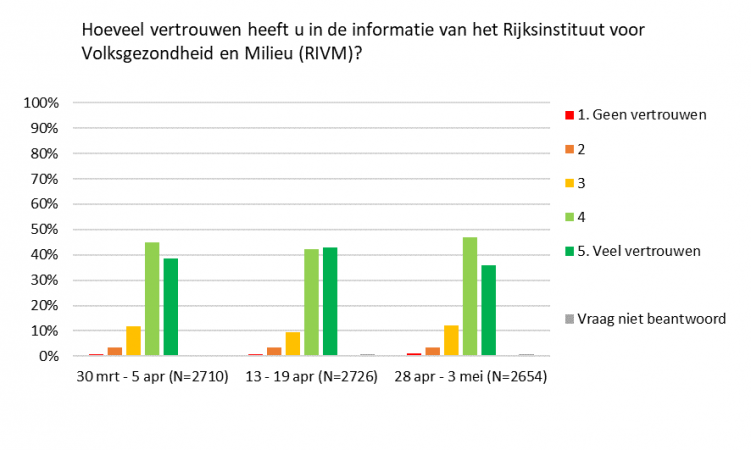
Trust in Information provided by the State (Fig. 13)
As this graphic shows the level of trust put in the information provided by officials was also consistently high throughout the crisis. As can be seen the broad majority of the population trusts the information offered by the National Institute for Public Health and the Environment (RIVM) strongly or completely. Relying on government information is especially important in the case of the Netherlands as the approach revolves heavily around insight and voluntary actions while the government itself acts in a more technocratic way.
5.2 Framing and Communication
Framing of a crisis is the act of constructing a narrative that provides the people with an understanding of what is going on and is very important for a government in uncertain times to ensure that people are on board with the measures taken.[66] Effective communication that ensures a high level of trust was in the case of the Dutch response probably even more important than in other nations response. This being due to the fact that the Netherlands decided to choose a path of recommending instead of restricting whenever possible following the country’s cultural history of liberalism. Such an approach is clearly more reliant on the understanding and compliance of the citizens.
The way the Dutch government framed the nature of the crisis and the way out of it is best understood by looking at the speech Prime Minister Mark Rutte gave during a tv-interview on March 16.[67] The way of framing of the crisis and possible solutions is exemplary for all of government communication during the crisis. This was the speech with which Rutte sent his country into lockdown. He emphasized that the virus is having the whole world in its grip. He said that “The reality is that coronavirus is here in our midst, and for the time being it is here to stay.” And that there will not be any quick or easy solutions. The two central points he mentioned again and again are that the crisis will last long and that the crisis is of enormous complexity. According to this perspective on the crisis he described his plans on how to manoeuvre through it. The by far best option available from the governments point of view would be to follow the advice of the persons who know best meaning science and experts. He explicitly mentions virologists, doctors and other medical specialists and the head of the Dutch National Institute for Public Health and Environment Jaap van Dissel. Van Dissel accompanied Rutte during many of his speeches and was one of the most dominant faces present during the crisis.
The second argument Rutte made was to make clear that the whole population of the Netherlands is facing this crisis together and will only be able to minimize the suffering from it if working together. He therefor very often uses the words “common” and variations of “we” in his speech. Examples are talking about “our country” that is at risk, that “we have to listen to experts”, that “we stand on common ground” and will have to have “common sense” in the crisis “we face together”. To look out for one another will be a term that continues to be included in government announcements.
The last important way the Dutch government communicates the crisis is by acknowledging the high level of uncertainty. Rutte makes an effort to highlight that much of the virus is unknown to this point and that despite understanding the urge of people to have clarity this will be likely to remain like that for quite some time. He also does not try to convince his citizens that the measures will always be one hundred per cent perfect. He instead emphasizes that as the knowledge about the virus changes measures might have to be changed or adjusted. The best way of taking measures while facing uncertainty is to follow the lead of experts and specialists. The rhetoric of “there is little we know certain” will be ongoing throughout the pandemic. Rutte warns the population not to be seduced by easy solutions and to be careful checking new developments as information right or wrong travel fast in the global world of ours.
As a conclusion it can be said that the Covid19-crisis is presented as a very threatening challenge society can only overcome as a whole. It is pictured as an emergency of health, rather complex and not tied to certain politics. Rutte shapes the image of politicians having to step back and listen to professional health experts and expects citizens to do the same. This way of framing the crisis is a very technocratic take that is considered to be effective in times of crisis. [68] He makes sure that every measure can and will be re-evaluated once there are new findings or developments. This readjusting is pictured as being the consequence of the uncertainty that accompanies the pandemic.
The way the Dutch government framed the nature of the crisis and the way out of it is best understood by looking at the speech Prime Minister Mark Rutte gave during a tv-interview on March 16.[67] The way of framing of the crisis and possible solutions is exemplary for all of government communication during the crisis. This was the speech with which Rutte sent his country into lockdown. He emphasized that the virus is having the whole world in its grip. He said that “The reality is that coronavirus is here in our midst, and for the time being it is here to stay.” And that there will not be any quick or easy solutions. The two central points he mentioned again and again are that the crisis will last long and that the crisis is of enormous complexity. According to this perspective on the crisis he described his plans on how to manoeuvre through it. The by far best option available from the governments point of view would be to follow the advice of the persons who know best meaning science and experts. He explicitly mentions virologists, doctors and other medical specialists and the head of the Dutch National Institute for Public Health and Environment Jaap van Dissel. Van Dissel accompanied Rutte during many of his speeches and was one of the most dominant faces present during the crisis.
The second argument Rutte made was to make clear that the whole population of the Netherlands is facing this crisis together and will only be able to minimize the suffering from it if working together. He therefor very often uses the words “common” and variations of “we” in his speech. Examples are talking about “our country” that is at risk, that “we have to listen to experts”, that “we stand on common ground” and will have to have “common sense” in the crisis “we face together”. To look out for one another will be a term that continues to be included in government announcements.
The last important way the Dutch government communicates the crisis is by acknowledging the high level of uncertainty. Rutte makes an effort to highlight that much of the virus is unknown to this point and that despite understanding the urge of people to have clarity this will be likely to remain like that for quite some time. He also does not try to convince his citizens that the measures will always be one hundred per cent perfect. He instead emphasizes that as the knowledge about the virus changes measures might have to be changed or adjusted. The best way of taking measures while facing uncertainty is to follow the lead of experts and specialists. The rhetoric of “there is little we know certain” will be ongoing throughout the pandemic. Rutte warns the population not to be seduced by easy solutions and to be careful checking new developments as information right or wrong travel fast in the global world of ours.
As a conclusion it can be said that the Covid19-crisis is presented as a very threatening challenge society can only overcome as a whole. It is pictured as an emergency of health, rather complex and not tied to certain politics. Rutte shapes the image of politicians having to step back and listen to professional health experts and expects citizens to do the same. This way of framing the crisis is a very technocratic take that is considered to be effective in times of crisis. [68] He makes sure that every measure can and will be re-evaluated once there are new findings or developments. This readjusting is pictured as being the consequence of the uncertainty that accompanies the pandemic.
5.3 Trust Overall vs. Trust in Certain Measures
Locking at the level of trust of the population of the Netherlands in the government throughout the crisis shows that the level of approval is continuously high. This might at first glace seem counterintuitive as there has been quite some disapproval with single measure imposed by the government which have also been voiced quite harshly.
The first protests against governmental measures arose when Prime Minister Rutte announced that schools would be kept open on March 12. Teachers felt unsafe as it was still unknown to which degree children could be infected and spread the virus to anyone else. Teacher unions started protesting and experts from the educational and medical sector voiced their concerns. The protests were that massive that Rutte had to readjust his course only three days later and announce that schools would be temporarily closed.[69]
Another similar instance occurred as the government tried to make a tracking app available with the aim of helping to test more efficiently. The first process of letting the app get developed by private business failed as concerns about data security were voiced and the selection process within the responsible committee was questioned. Several experts wrote an open letter addressing their concerns. The government had once again to readjust its course and announce that instead of private developers the state will construct its own app which will be available on a voluntary basis. Whether such an app is a good idea has divided the country.
These two cases show that single measures have been very unpopular within the general public and that in such a case the government gave in to the pressure. However, it appears that neither the unpopular measures themselves nor the government changing its mind has damaged the overall support of government. The reason behind this might be with high chances the way of communication which was always clear and addressing the possibility of readjustments and uncertainty from the beginning.
The first protests against governmental measures arose when Prime Minister Rutte announced that schools would be kept open on March 12. Teachers felt unsafe as it was still unknown to which degree children could be infected and spread the virus to anyone else. Teacher unions started protesting and experts from the educational and medical sector voiced their concerns. The protests were that massive that Rutte had to readjust his course only three days later and announce that schools would be temporarily closed.[69]
Another similar instance occurred as the government tried to make a tracking app available with the aim of helping to test more efficiently. The first process of letting the app get developed by private business failed as concerns about data security were voiced and the selection process within the responsible committee was questioned. Several experts wrote an open letter addressing their concerns. The government had once again to readjust its course and announce that instead of private developers the state will construct its own app which will be available on a voluntary basis. Whether such an app is a good idea has divided the country.
These two cases show that single measures have been very unpopular within the general public and that in such a case the government gave in to the pressure. However, it appears that neither the unpopular measures themselves nor the government changing its mind has damaged the overall support of government. The reason behind this might be with high chances the way of communication which was always clear and addressing the possibility of readjustments and uncertainty from the beginning.
5.4 Party Approval
The trust in government in general is also shown by the approval ratings of the People´s Party for Freedom and Democracy (VVD), the party of prime minister Rutte. During the beginning of the crisis Rutte and his party gained steadily from roughly 20 per cent in the beginning of March to 30 per cent in the end of it. While this might be due to a “rallying around the flag” effect, typical for a populations first reaction to a threatening crisis, the approval ratings increased further steadily and afterwards remained consistent on a strong number of 36 per cent. During the same period other Dutch parties could not gain more support across the population but instead remained on a consistent level of approval.
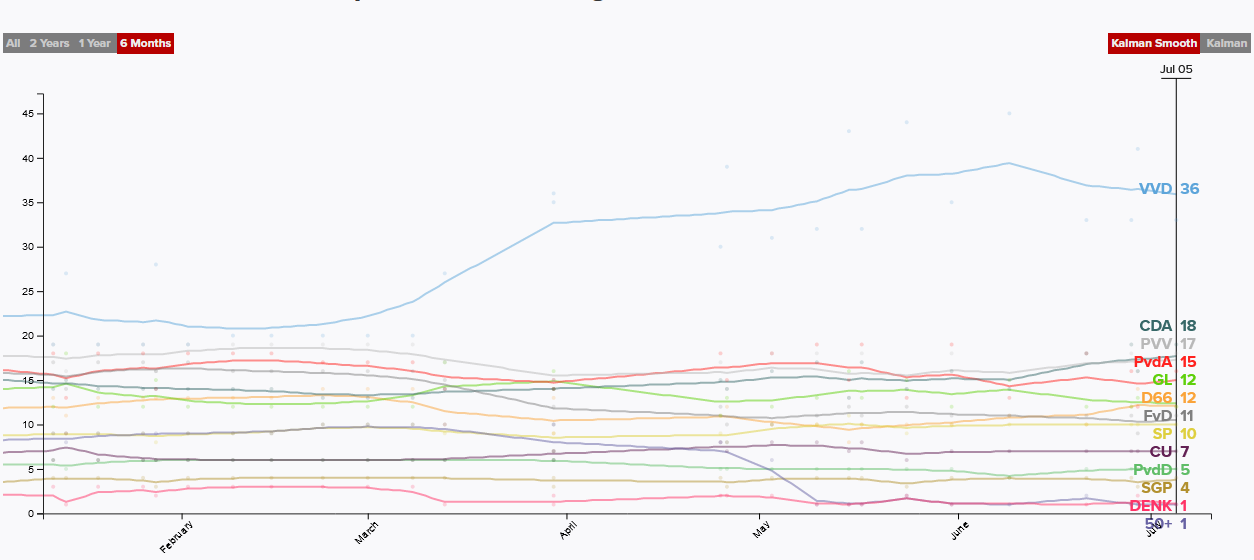
Party Approval Ratings during the Crisis (Fig. 14)
6 Evaluation
A real overall evaluation on the Dutch response to the Covid19-pandemic might be only possible after the end of the crisis. But there is still the possibility of analysing the success of certain measures especially in comparison with other countries. The Dutch approach in the beginning of the crisis had sparked scepticism and criticism among other countries. It was often portrayed as being a “high-risk experiment”[70] with potentially fatal consequences[71] . As the numbers increased the country shifte its course which can be evaluated as the correct step. Countries who continued on the liberal path of keeping the country open as the United Kongdom did for a long time or Sweden throughout the crisis have suffered from higher mortality rates as the Dutch.
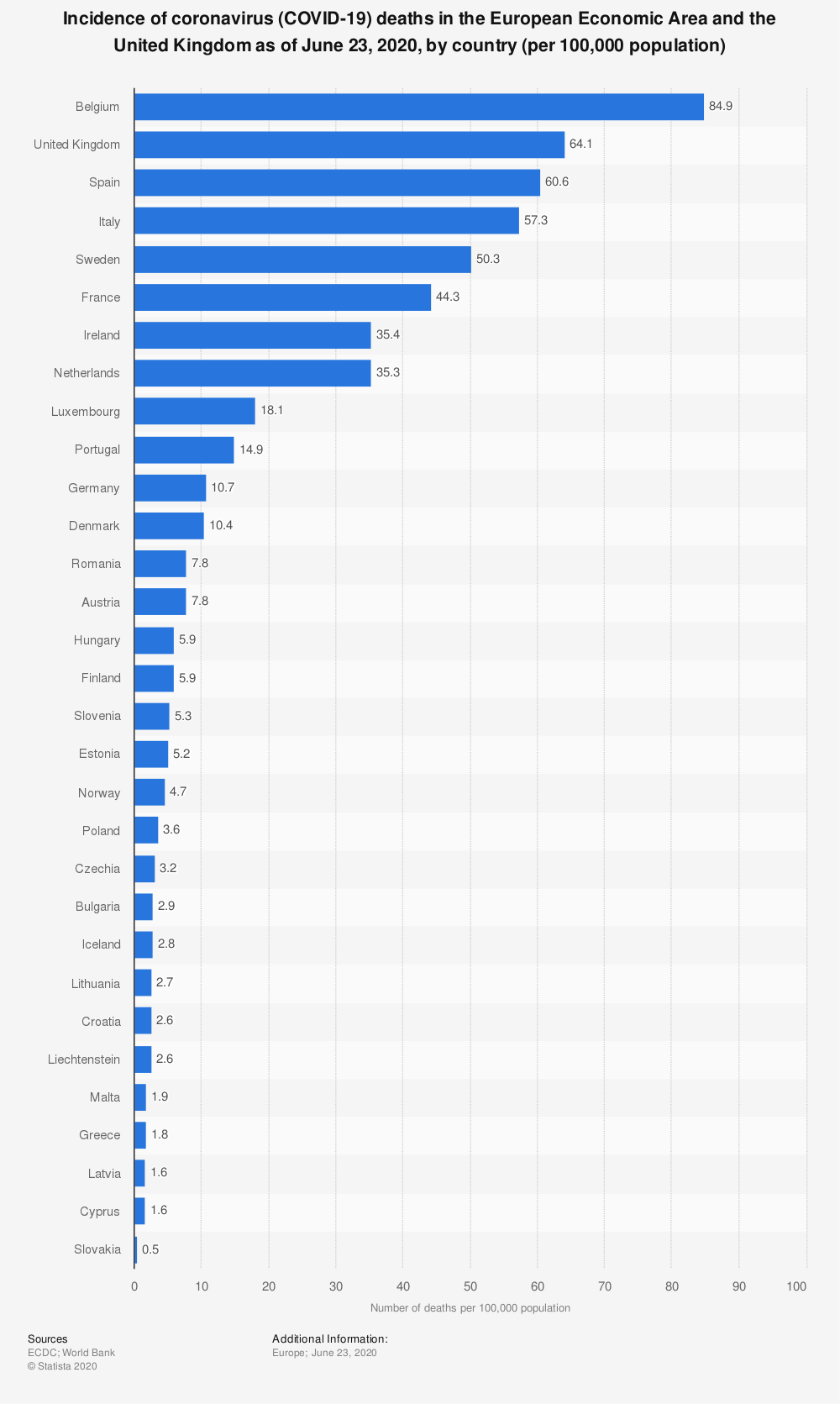
Mortality Rate in European Comparison (Fig. 15)
The decision to have a soft lock down instead of a hard one seems not to have had negative consequences for the country. The Netherlands were able to flatten the curve two weeks after the soft lockdown took place and the number of new cases did not differ to a great degree from countries which had a hard lockdown in place such as France or Germany. However, what should be mentioned that recent research indicates that the idea of of being immune after an infection seems not to hold so at least the initial reasoning given by the Dutch government has proven not to be effective.
An interesting comparison can be drawn between the Netherlands and the Asian countries which were succesfull in implementing an app to monitor infected citizens as it was done in South Korea and Taiwan. Especially a comparison with the country of Taiwan is interesting as both countries share a set of characteristics. Both countries are populated densely and have a roughly equal population size (17 million people in the Netherlands to 24 million people in Taiwan). Both countries decided against a complete shut down of public life and the economy. People could go to work, and stores remained open. But while the Netherlands had to fight hard to flatten the infection curve there was nearly no curve in Taiwan. A crucial part in explaining this observation is most likely the electronical monitoring that has been a core aspect of the Taiwanese approach. If a patient gets to the hospital with symptoms of Covid19 it has to be reported to the centralised epidemic command centre. A digital footprint is conducted by tracking where the person has been and who was next to them. These persons receive a warning through a text message. This was exactly what the Dutch government planned on doing after it became apparent that the country could not be kept open. The liberal values of the Netherlands prevented a heavy state monitoring from taking place. The strategy of Taiwan and also South Korea is highly succesfull, and some people have argued that In the end not having such an app has led to movement restrictions in the Netherlands which were not necessary in Taiwan. The more compliance demanding approach of Taiwan provided thereby ultimately more freedom in movement while keeping infections at a minimum[72] . Does that mean not implementing a mandatory app should be considered a failure? This question is rather impossible to answer and more of a philosophical one. While it is apparent that such an app is an effective tool to contain the spreading of the virus it is also has the potential to be a severe intervention in personal privacy. If it is a risk worth taking depends on an individuals point of view and can thereby not be answered generally.
An other country which had great success in fighting Covid19 was New Zealand. However as has been stated numerous times by dutch government officials the Netherlands are not an isle. Instead they are a very open country and have to be so as the Netherlands are highly reliant on trade and its neighbouring countries. Isolating from the world is not possible in such a case especially in such a highly connected and dependent of each other area as the European Union.
The comunication of the Dutch government can be evaluated as being exceptionally well. Rutte and the members of his government have chosen a very technocratic approach, emphasizing the importance of expert knowledge. Not only that but the adressing of uncertainty which was a core element of official communication seems to be very effective. It also appears that putting high trust in the Dutch citizens has paid of quite largely. People are willing to listen to government recommendations and believe in the information they are given by officials. This trust can be seen as the most precious resource the Netherlands have compared with many other countries. There is no protesting against government measures like in Germany or in the United States. The high level of support of government measures could be especially important in case of a second wave in autumn.
The pragmatic way of readjusting the strategy multiple times has also paid off. While it might at first glance seem inconsistent, Dutch citizens were thankfull for the flexibility and responsiveness and paid it back with trust and support. This is also in lign with existing crisis literature. Being pragmatic and adressing uncertainty are factors which are deemed to be crucial in crisis management.[73] Both of which the Netherlands are a prime example of. To make a conclusion it can be said that implementing or not implementing certain measures might be considered wrong in retrospective but the overall process of learning and adapting is exactly what is necessary in times of crisis.
An interesting comparison can be drawn between the Netherlands and the Asian countries which were succesfull in implementing an app to monitor infected citizens as it was done in South Korea and Taiwan. Especially a comparison with the country of Taiwan is interesting as both countries share a set of characteristics. Both countries are populated densely and have a roughly equal population size (17 million people in the Netherlands to 24 million people in Taiwan). Both countries decided against a complete shut down of public life and the economy. People could go to work, and stores remained open. But while the Netherlands had to fight hard to flatten the infection curve there was nearly no curve in Taiwan. A crucial part in explaining this observation is most likely the electronical monitoring that has been a core aspect of the Taiwanese approach. If a patient gets to the hospital with symptoms of Covid19 it has to be reported to the centralised epidemic command centre. A digital footprint is conducted by tracking where the person has been and who was next to them. These persons receive a warning through a text message. This was exactly what the Dutch government planned on doing after it became apparent that the country could not be kept open. The liberal values of the Netherlands prevented a heavy state monitoring from taking place. The strategy of Taiwan and also South Korea is highly succesfull, and some people have argued that In the end not having such an app has led to movement restrictions in the Netherlands which were not necessary in Taiwan. The more compliance demanding approach of Taiwan provided thereby ultimately more freedom in movement while keeping infections at a minimum[72] . Does that mean not implementing a mandatory app should be considered a failure? This question is rather impossible to answer and more of a philosophical one. While it is apparent that such an app is an effective tool to contain the spreading of the virus it is also has the potential to be a severe intervention in personal privacy. If it is a risk worth taking depends on an individuals point of view and can thereby not be answered generally.
An other country which had great success in fighting Covid19 was New Zealand. However as has been stated numerous times by dutch government officials the Netherlands are not an isle. Instead they are a very open country and have to be so as the Netherlands are highly reliant on trade and its neighbouring countries. Isolating from the world is not possible in such a case especially in such a highly connected and dependent of each other area as the European Union.
The comunication of the Dutch government can be evaluated as being exceptionally well. Rutte and the members of his government have chosen a very technocratic approach, emphasizing the importance of expert knowledge. Not only that but the adressing of uncertainty which was a core element of official communication seems to be very effective. It also appears that putting high trust in the Dutch citizens has paid of quite largely. People are willing to listen to government recommendations and believe in the information they are given by officials. This trust can be seen as the most precious resource the Netherlands have compared with many other countries. There is no protesting against government measures like in Germany or in the United States. The high level of support of government measures could be especially important in case of a second wave in autumn.
The pragmatic way of readjusting the strategy multiple times has also paid off. While it might at first glance seem inconsistent, Dutch citizens were thankfull for the flexibility and responsiveness and paid it back with trust and support. This is also in lign with existing crisis literature. Being pragmatic and adressing uncertainty are factors which are deemed to be crucial in crisis management.[73] Both of which the Netherlands are a prime example of. To make a conclusion it can be said that implementing or not implementing certain measures might be considered wrong in retrospective but the overall process of learning and adapting is exactly what is necessary in times of crisis.
7 Stay at Home Song
The song "17 Miljonen Mensen" by Davina Michelle and Snelle[74] adressed the feeling of uncertainty and loneliness in times of Covid and was for several weeks number one in the charts during the most critical weeks in March and April.
17 Miljoen Mensen
8 Sources
8.1 Graphs & Figures
Figure 1: Freeworldmaps, URL: https://www.freeworldmaps.net/europe/netherlands/map.html Accessed: 29.07.2020
Figure 2: OECD, URL: https://data.oecd.org/healtheqt/hospital-beds.htm, Accessed: 29.07.2020
Figure 3: Rhodes, A., Ferdinande, P., Flaatten, H., Guidet, B., Metnitz, P. G., & Moreno, R. P. (2012). The variability of critical care bed numbers in Europe. Intensive Care Medicine, 38(10), 1647–1653. https://doi.org/10.1007/s00134-012-2627-8
Figure 4: The Full Wiki, URL: http://www.thefullwiki.org/The_Netherlands Accessed: 29.09.2020
Figure 5: Statista, URL: https://www.statista.com/statistics/1101612/coronavirus-cases-by-city-in-the-netherlands/ Accessed: 29.07.2020
Figure 6: WorldOMeter, URL: https://www.worldometers.info/coronavirus/country/netherlands/ Accessed: 29.09.2020
Figure 7: WorldOMeter, URL: https://www.worldometers.info/coronavirus/country/netherlands/ Accessed: 29.09.2020
Figure 8: WorldOMeter, URL: https://www.worldometers.info/coronavirus/country/netherlands/ Accessed: 29.09.2020
Figure 9: WorldOMeter, URL: https://www.worldometers.info/coronavirus/country/netherlands/ Accessed: 29.09.2020
Figure 10: Our World in Data, URL: https://ourworldindata.org/coronavirus-testing#netherlands Accessed: 29.09.2020
Figure 11: Underlying Graphic: Statista, URL: https://www.statista.com/statistics/1101300/coronavirus-cases-in-netherlands/ , with own timeline above Accessed: 29.07.2020
Figure 12: RIVM, URL: https://www.rivm.nl/en/novel-coronavirus-covid-19/research/public-perception-of-the-corona-crisis Accessed: 29.07.2020
Figure 13: RIVM, URL: https://www.rivm.nl/en/novel-coronavirus-covid-19/research/public-perception-of-the-corona-crisis Accessed: 29.07.2020
Figure 14: Polico, URL: https://www.politico.eu/europe-poll-of-polls/netherlands/ Accessed : 29.07.2020
Figure 15 : Statista, URL : https://www.statista.com/statistics/1111779/coronavirus-death-rate-europe-by-country/ Accessed : 29.07.2020
Figure 2: OECD, URL: https://data.oecd.org/healtheqt/hospital-beds.htm, Accessed: 29.07.2020
Figure 3: Rhodes, A., Ferdinande, P., Flaatten, H., Guidet, B., Metnitz, P. G., & Moreno, R. P. (2012). The variability of critical care bed numbers in Europe. Intensive Care Medicine, 38(10), 1647–1653. https://doi.org/10.1007/s00134-012-2627-8
Figure 4: The Full Wiki, URL: http://www.thefullwiki.org/The_Netherlands Accessed: 29.09.2020
Figure 5: Statista, URL: https://www.statista.com/statistics/1101612/coronavirus-cases-by-city-in-the-netherlands/ Accessed: 29.07.2020
Figure 6: WorldOMeter, URL: https://www.worldometers.info/coronavirus/country/netherlands/ Accessed: 29.09.2020
Figure 7: WorldOMeter, URL: https://www.worldometers.info/coronavirus/country/netherlands/ Accessed: 29.09.2020
Figure 8: WorldOMeter, URL: https://www.worldometers.info/coronavirus/country/netherlands/ Accessed: 29.09.2020
Figure 9: WorldOMeter, URL: https://www.worldometers.info/coronavirus/country/netherlands/ Accessed: 29.09.2020
Figure 10: Our World in Data, URL: https://ourworldindata.org/coronavirus-testing#netherlands Accessed: 29.09.2020
Figure 11: Underlying Graphic: Statista, URL: https://www.statista.com/statistics/1101300/coronavirus-cases-in-netherlands/ , with own timeline above Accessed: 29.07.2020
Figure 12: RIVM, URL: https://www.rivm.nl/en/novel-coronavirus-covid-19/research/public-perception-of-the-corona-crisis Accessed: 29.07.2020
Figure 13: RIVM, URL: https://www.rivm.nl/en/novel-coronavirus-covid-19/research/public-perception-of-the-corona-crisis Accessed: 29.07.2020
Figure 14: Polico, URL: https://www.politico.eu/europe-poll-of-polls/netherlands/ Accessed : 29.07.2020
Figure 15 : Statista, URL : https://www.statista.com/statistics/1111779/coronavirus-death-rate-europe-by-country/ Accessed : 29.07.2020
8.2 Literature
[1] Bureau for Tourism and Congresses of the Netherlands, URL: https://www.holland.com/global/tourism/information/general/facts-figures.htm Accessed: 24.05.2020
[2] Ministry of Agriculture, Nature and Food of the Netherlands, URL: https://www.government.nl/topics/agriculture Accessed: 24.05.2020
[3] Worldbank, URL: https://data.worldbank.org/country/NL Accessed: 24.05.2020
[4] Human Development Report, URL: http://hdr.undp.org/en/countries/profiles/NLD Accessed: 29.06.2020
[5] Oshitani, H., Kamigaki, T., & Suzuki, A. (2008). Major Issues and Challenges of Influenza Pandemic Preparedness in Developing Countries. Emerging Infectious Diseases, 14(6), 875–880. https://doi.org/10.3201/eid1406.070839
[6] Eurostat, URL: https://ec.europa.eu/eurostat/statistics-explained/index.php/Healthcare_expenditure_statistics Accessed: 27.05.2020
[7] Bundeszentrale für Politische Bildung, URL: https://www.bpb.de/politik/innenpolitik/gesundheitspolitik/72969/finanzierung Accessed: 25.05.2020
[8] Universität Münster, URL: https://www.uni-muenster.de/NiederlandeNet/aktuelles/archiv/2015/februar/0205gesundheitssystem.html Accessed: 25.05.2020
[9] Universität Münster, URL: https://www.uni-muenster.de/NiederlandeNet/nl-wissen/soziales/zusammenarbeit/gesundheitsraum.html Accessed: 25.05.2020
[10] DutchNews, URL: https://www.dutchnews.nl/news/2020/01/the-netherlands-is-well-prepared-for-the-coronavirus-health-official-says/ Accessed: 07.06.2020
[11] Global Health Security Index, URL: https://www.ghsindex.org/about/ Accessed: 23.06.2020
[12] Rhodes, A., Ferdinande, P., Flaatten, H., Guidet, B., Metnitz, P. G., & Moreno, R. P. (2012). The variability of critical care bed numbers in Europe. Intensive Care Medicine, 38(10), 1647–1653. https://doi.org/10.1007/s00134-012-2627-8
[13] Maitlis, S., & Sonenshein, S. (2010). Sensemaking in Crisis and Change: Inspiration and Insights From Weick (1988). Journal of Management Studies, 47(3), 551–580. https://doi.org/10.1111/j.1467-6486.2010.00908.x
[14] American Association for Advancement of Science, URL: https://www.sciencemag.org/news/2020/03/standard-coronavirus-test-if-available-works-well-can-new-diagnostics-help-pandemic Accessed: 23.06.2020
[15] Dutch Ministry of Health, Welfare and Sport, URL: https://www.government.nl/topics/coronavirus-covid-19/news/2020/02/27/man-diagnosed-with-coronavirus-covid-19-in-the-netherlands, Accessed: 25.06.2020
[16] I Am Expat, URL: https://www.iamexpat.nl/expat-info/dutch-expat-news/netherlands-coronavirus-tracked-12-days-first-case, Accessed: 25.06.2020
[17] Dutch Ministry of Health, Welfare and Sport, URL: https://www.government.nl/topics/coronavirus-covid-19/news/2020/03/06/patient-with-novel-coronavirus-deceased, Accessed: 24.06.2020
[18] DutchNews, URL: https://www.dutchnews.nl/news/2020/03/coronavirus-why-are-there-so-many-cases-in-noord-brabant/ Accessed: 25.06.2020
[19] WorldOMeter, URL: https://www.worldometers.info/coronavirus/country/netherlands/ Accessed: 29.07.2020
[20] Dutch National Institute for Public Health and the Environment, URL: https://www.rivm.nl/en/node/154261 Accessed: 17.06.2020
[21] DutchNews, URL: https://www.dutchnews.nl/news/2020/03/the-who-says-test-test-test-so-what-is-the-dutch-strategy/ Accessed: 17.06.2020
[22] I Am Expat, URL: https://www.iamexpat.nl/expat-info/dutch-expat-news/netherlands-offered-5000-extra-tests-day-german-laboratory Accessed: 17.06.2020
[23] Dutch National Institute for Public Health and the Environment, URL: https://www.rivm.nl/en/novel-coronavirus-covid-19/testing-for-covid-19 Accessed: 17.06.2020
[24] Dutch Ministry of Health, Welfare and Sport, URL: https://www.government.nl/topics/coronavirus-covid-19/news Accessed: 24.06.2020
[25] Dutch Ministry of Health, Welfare and Sport, URL: https://www.government.nl/topics/coronavirus-covid-19/news/2020/06/01/initial-investigation-results-infections-at-three-more-mink-farms Accessed: 28.06.2020
[26] Dutch Ministry of Health, Welfare and Sport, URL: https://www.government.nl/topics/coronavirus-covid-19/news/2020/06/09/government-adopts-advice-to-cull-mink-on-infected-farms Accessed: 28.06.2020
[27] Encyclopedia Britannica, URL: https://www.britannica.com/topic/executive-government Accessed 29.07.2020
[28] NL-Times, URL: https://nltimes.nl/2020/03/09/dutch-pm-stop-shaking-hands-coronavirus-kills-4th-spreads-100-municipalities Accessed: 24.06.2020
[29] Ministry of Health, Welfare and Sport, URL: https://www.government.nl/latest/news/2020/03/12/new-measures-to-stop-spread-of-coronavirus-in-the-netherlands Accessed: 24.06.2020
[30] DutchNews, URL: https://www.dutchnews.nl/news/2020/03/the-netherlands-cancels-big-events-but-wont-close-schools-in-corona-clampdown/ Accessed: 24.06.2020
[31] Ministry of Health, Welfare and Sport, URL: https://www.government.nl/topics/coronavirus-covid-19/news/2020/03/15/additional-measures-in-schools-the-hospitality-sector-and-sport Accessed: 24.06.2020
[32] Ministry of Health, Welfare and Sport, URL: https://www.government.nl/documents/speeches/2020/03/16/television-address-by-prime-minister-mark-rutte-of-the-netherlands Accessed: 24.06.2020
[33] Ministry of Health, Welfare and Sport, URL: https://www.government.nl/topics/coronavirus-covid-19/news/2020/03/23/stricter-measures-to-control-coronavirus Accessed 24.06.2020
[34] Ministry of Health, Welfare and Sport, URL: https://www.government.nl/topics/coronavirus-covid-19/news/2020/03/31/measures-to-combat-coronavirus-extended-until-tuesday-28-april-inclusive Accessed: 24.06.2020
[35] Ministry of Health, Welfare and Sport, URL: https://www.government.nl/topics/coronavirus-covid-19/news/2020/04/21/measures-to-stop-the-spread-of-coronavirus-extended Accessed: 28.06.2020
[36] Ministry of Health, Welfare and Sport, URL: https://www.government.nl/topics/coronavirus-covid-19/news/2020/05/06/avoid-busy-places-and-stay-1.5-metres-away-from-others Accessed: 28.06.2020
[37] Ministry of Health, Welfare and Sport, URL: https://www.government.nl/topics/coronavirus-covid-19/news/2020/05/28/press-conference-of-27-may-current-roadmap-of-measures-against-coronavirus Accessed: 28.06.2020
[38] The Hague Online, URL: https://www.thehagueonline.com/news/2020/04/07/rutte-plans-to-beat-covid-19-with-apps Accessed: 29.06.2020
[39] DutchNews, URL: https://www.dutchnews.nl/news/2020/04/dutch-see-apps-as-key-to-relaxing-lockdown-tracing-corona-suspects/ Accessed: 29.06.2020
[40] DutchNews, URL: https://www.dutchnews.nl/news/2020/04/experts-criticise-dutch-governments-approach-to-coronavirus-app/ Accessed: 24.06.2020
[41] EU Observer, URL: https://euobserver.com/opinion/148265 Accessed: 24.06.2020
[42] ASSOCC, URL: https://simassocc.org/scenario-effect-of-tracktrace-apps/ Accessed: 24.06.2020
[43] NL-Times, URL: https://nltimes.nl/2020/06/09/dutch-divided-coronavirus-tracking-app Accessed: 24.06.2020
[44] OVLG, URL: https://decoronacheck.nl/ Accessed: 24.06.2020
[45] DutchNews, URL: https://www.dutchnews.nl/news/2020/04/app-to-monitor-corona-infection-available-nationwide-olvg-starts-trial-testing/ Accessed: 24.06.2020
[46] Ministry of Health, Welfare and Sport, URL: https://www.government.nl/topics/coronavirus-covid-19/news/2020/03/15/coronavirus-expanded-sme-credit-guarantee-scheme-gets-accelerated-launch Accessed: 26.06.2020
[47] Ministry of Health, Welfare and Sport, URL: https://www.government.nl/latest/news/2020/03/19/coronavirus-dutch-government-adopts-package-of-new-measures-designed-to-save-jobs-and-the-economy Accessed: 26.06.2020
[48] Ministry of Health, Welfare and Sport, URL: https://www.government.nl/topics/coronavirus-covid-19/news/2020/06/26/government-offers-financial-support-to-klm-as-a-result-of-the-corona-crisis Accessed: 26.06.2020
[49] Ministry of Health, Welfare and Sport, URL: https://www.government.nl/topics/coronavirus-covid-19/news/2020/03/17/travel-advice-only-travel-abroad-if-essential Accessed: 26.06.2020
[50] Ministry of Health, Welfare and Sport, URL: https://www.government.nl/topics/coronavirus-covid-19/news/2020/03/18/the-netherlands-closes-its-borders-to-persons-from-outside-europe Accessed: 26.06.2020
[51] Ministry of Health, Welfare and Sport, URL: https://www.government.nl/topics/coronavirus-covid-19/news/2020/03/22/cross-border-commuters-working-in-crucial-sectors-can-get-vignette-to-pass-belgian-border-with-priority Accessed: 26.06.2020
[52] Ministry of Health, Welfare and Sport, URL: https://www.government.nl/topics/coronavirus-covid-19/news/2020/06/03/if-you%E2%80%99re-going-on-holiday-make-sure-you-travel-smart Accessed: 26.06.2020
[53] Ministry of Health, Welfare and Sport, URL: https://www.government.nl/topics/coronavirus-covid-19/news/2020/06/15/tourists-from-the-netherlands-can-now-holiday-in-16-european-countries Accessed: 26.06.2020
[54] Ministry of Health, Welfare and Sport, URL: https://www.government.nl/topics/coronavirus-covid-19/news/2020/06/30/the-netherlands-lift-travel-ban-for-certain-groups-of-travellers Accessed: 03.07.2020
[55] Ministry of Health, Welfare and Sport, URL: https://www.government.nl/topics/coronavirus-covid-19/news/2020/07/16/minister-grapperhaus-relaxes-rules-for-long-distance-relationships Accessed: 29.07.2020
[56] Ministry of Health, Welfare and Sport, URL: https://www.government.nl/topics/coronavirus-covid-19/news/2020/05/08/statement-netherlands-belgium-and-germany-on-slowing-down-the-spread-of-covid-19 Accessed: 26.06.2020
[57] Ministry of Health, Welfare and Sport, URL: https://www.government.nl/topics/coronavirus-covid-19/news/2020/06/03/france-germany-italy-and-the-netherlands-working-together-to-find-a-vaccine-for-countries-in-europe-and-beyond Accessed: 26.06.2020
[58] Ministry of Health, Welfare and Sport, URL: https://www.government.nl/topics/coronavirus-covid-19/news/2020/03/23/stricter-measures-to-control-coronavirus Accessed: 21.06.2020
[59] Baldwin, P. (2005). Beyond Weak and Strong: Rethinking the State in Comparative Policy History. Journal of Policy History, 17(1), 12–33. https://doi.org/10.1353/jph.2005.0002
[60] Penn State University, URL: https://sites.psu.edu/psy533buban/2016/02/05/l03-deontology-vs-utilitarianism-the-eternal-battle/ Accessed 28.06.2020
[61] Spiegel Online, URL: https://www.spiegel.de/wissenschaft/medizin/corona-herdenimmunitaet-gegen-shutdown-was-ist-besser-a-2b124ee6-4614-4a4b-96a0-e393f2cfeff9 Accessed: 27.06.2020
[62] Ministry of Health, Welfare and Sport, URL: https://www.government.nl/topics/coronavirus-covid-19/news/2020/07/16/minister-grapperhaus-relaxes-rules-for-long-distance-relationships Accessed: 29.06.2020
[63] Universität Münster, URL: https://www.uni-muenster.de/NiederlandeNet/nl-wissen/soziales/homosexualitaet/index.html Accessed: 18.06.2020
[64] Universität Münster, URL:https://www.uni-muenster.de/NiederlandeNet/nl-wissen/rechtjustiz/drogengesetzgebung/drogenpolitik.html Accessed: 18.06.2020
[65] Encyclopedia Britannica, URL: https://www.britannica.com/topic/legitimacy Accessed 29.07.2020
[66] Boin, A., t Hart, P., Stern, E., & Sundelius, B. (2017). Meaning Making: Constructing a Crisis Narrative. The Politics of Crisis Management, 78–101. https://doi.org/10.1017/9781316339756.005
[67] Ministry of Health, Welfare and Sport, URL: https://www.government.nl/documents/speeches/2020/03/16/television-address-by-prime-minister-mark-rutte-of-the-netherlands Accessed: 21.06.2020
[68] Amat, F., Arenas, A., Falcó-Gimeno, A., & Muñoz, J. (2020, April 6). Pandemics meet democracy. Experimental evidence from the COVID-19 crisis in Spain. https://doi.org/10.31235/osf.io/dkusw
[69] Reuters, URL: https://www.reuters.com/article/us-health-coroavirus-netherlands/netherlands-to-close-schools-restaurants-in-coronavirus-fight-idUSKBN2120KG Accessed: 28.06.2020
[70] BBC, URL: https://www.bbc.com/news/world-europe-52135814 Accessed: 28.06.2020
[71] Süddeutsche Zeitung, URL: https://www.sueddeutsche.de/politik/coronavirus-niederlande-herdenimmunitaet-1.4850134 Accessed: 28.06.2020
[72] The Guardian, URL: https://www.theguardian.com/commentisfree/2020/may/19/liberal-dutch-taiwan-coronavirus-covid-19-netherlands Accessed: 28.06.2020
[73] Ansell, C., & Boin, A. (2017). Taming Deep Uncertainty: The Potential of Pragmatist Principles for Understanding and Improving Strategic Crisis Management. Administration & Society, 51(7), 1079–1112. https://doi.org/10.1177/0095399717747655
[74] Davina Michelle & Snelle, URL: https://www.youtube.com/watch?v=CjJkahGWBPI, Accessed: 29.06.2020